The Use of Online Current Awareness Services by Natural Sciences and Engineering Faculty at Western Michigan University
Carrie C. Leatherman
Assistant Professor
carrie.leatherman@wmich.edu
Edward J. Eckel
Assistant Professor
edward.eckel@wmich.edu
Western Michigan University
Kalamazoo, Michigan
Abstract
Nearly every commercial database that covers natural sciences and engineering offers some type of current awareness (CA) service that provides regular updates to users on current literature in a selected field of interest. Current awareness services include e-mail alerts, tables of contents, and RSS feeds. This study was designed to find out what percentage of natural sciences and engineering faculty at Western Michigan University (WMU) uses online CA services, what types of CA tools they use, how useful they find these tools, and whether faculty would be interested in a library training session that covered such tools. We invited WMU natural sciences and engineering faculty to take a 13-question survey. We found that e-mail alerts were the most often-used CA service; few researchers used RSS feeds. Most researchers used the services to alert them to research in a specific subject area. Awareness of other researchers in specific areas was the most frequently cited contribution of CA services. A significant number of natural sciences and engineering faculty at WMU would be interested in library instruction about CA services, although whether they would take advantage of such instruction is uncertain.
Introduction
Scientists and engineers have an ongoing need to keep up with new research developments in their fields. Whether in the form of e-mail alerts, online bulletins, or RSS feeds, these current awareness (CA) services may collate the results of a prescribed database search, inform the user of citations to a particular article, or distribute the tables of contents to new journal issues. Such updates can save a researcher's time (Bowman and Brown 1971; Garfield and Sher 1967; Menzel 1964; Strauss, et al. 1964) and money (Martyn 1964), reduce delays due to research duplication (Aims 1965; Martyn 1964), and prevent information overload (Rosch 2003).
CA services are offered by database companies such as Elsevier (publisher of Engineering Village, ScienceDirect, SciVerse, and Scopus), ProQuest, and Thomson Reuters (publisher of the Web of Science, Biosis Previews, and INSPEC), and scholarly publishers such as the American Chemical Society, Springer, and John Wiley. Table 1 below illustrates a number of basic CA services offered by well-known science and engineering databases subscribed to by Western Michigan University Libraries. As shown in this table, almost every science and technology database offers some kind of CA tool.
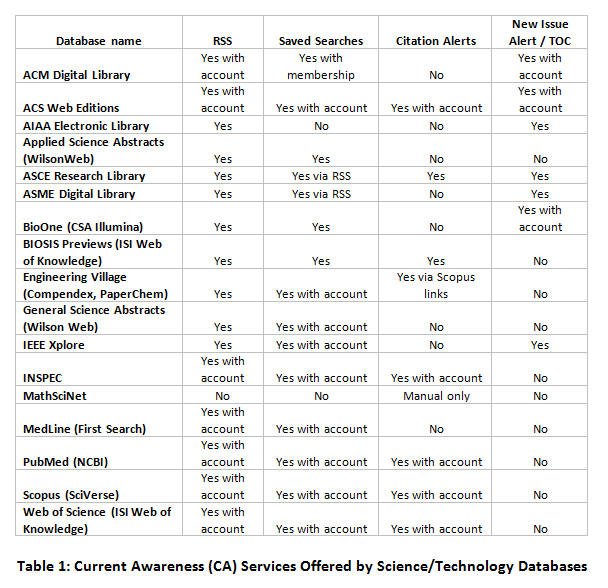
Despite the convenience and seeming ubiquity of the various CA services, there remains some question whether such services are actually used by science and technology researchers (Sullivan 2004). Just because a research tool or service exists does not guarantee its use by scholars. Even the relatively small learning curve required to set up or subscribe to an RSS feed or e-mail alert may be sufficient to prevent a busy faculty member from taking advantage of it. Researchers barely have time to search databases or read the scholarly literature that comes across their desks as it is, let alone take the time to learn how to use a feed reader/aggregator like Bloglines or Google Reader (Blackburn and Walker 2008). Surveying faculty in the natural sciences and engineering disciplines can provide a reality check on whether or not such services are used and how often. Knowing how and how much science/technology faculty use CA services would enable librarians to educate faculty more effectively so that faculty could take better advantage of such tools. In addition, librarians could provide useful feedback to the database companies and scholarly publishers.
Literature Review
The International Encyclopedia of Information and Library Science defines a current awareness service as one "notifying current documents to users of libraries and information services" (Current awareness 2003). Strauss, Strieby and Brown (1964) offer a more detailed definition: "a system for reviewing publications immediately upon receipt, selecting information pertinent to the program of the organization served, and noting individual items to be brought to the attention...of those persons to whose work they are related." Put another way, "the scientist has… a 'standing order' for all new information" (Menzel 1964). A CA service may be concisely defined as any online or print resource that provides regular updates to users on current literature in a research field of interest. The emphasis is on currency.
Such resources or services may include paper or online bulletins, journal tables of contents, RSS feeds from web sites and online databases, e-mail alerts, citation indexes, saved database searches, online peer networks (for example, ProQuest's Community of Science), and blogs. Many of these services overlap. For example, journal tables of contents and saved searches are commonly available as both e-mail alerts and RSS feeds. CA services are often known by other names as well, including selective dissemination of information or SDI (Connor 1967; Hensley 1963; Kolder and Simpkins 1967), "Current Contents" (Current contents list 2003), and alerting services. SDI has generally referred to CA services based on an individual researcher's personal research profile (Connor 1967; Rosch 2003; Strauss, et al. 1964) rather than widely disseminated to a general readership, although many definitions such as that offered by Luhn (1961) and Hensley (1963) can make SDI and CA seem almost synonymous.
Current awareness and information dissemination services have been around in some form for at least 80 years. Skolnik (1977) describes a current awareness bulletin that began in 1929 for chemists and researchers at the Hercules Corporation and was moved to a computer system in the 1960s. Such early CA services were usually librarian-generated bulletins distributed "in house" to researchers in corporate, university, or government research centers as a means for keeping up with the vastly expanding post-World War II research output (Kolder and Simpkins 1967; Menzel 1964; Skolnik 1977; Strauss, et al. 1964).
Only in the current Internet era, however, with the advent of saved searches, e-mail alerts, and RSS feeds, have such CA services become relatively convenient for users to set up and maintain on their own. RSS feeds, also known as "Really Simple Syndication" (Wittenbrink 2005) and "Rich Site Summary" (King 2001), are XML files that enable users to track new updates to a web site without having to visit that web site over and over (Wittenbrink 2005). Once used primarily to gather news and updates from web sites for convenient access and reading, RSS is now widely used by scholarly publishers and database companies to syndicate database and tables-of-contents alerts.
Connor (1967) emphasized that "participation in the SDI system should make a minimum demand on the user's time and should be an uncomplicated procedure." It is worth asking if this is the case. There is some evidence that users may not be aware of tools such as RSS feeds (Grossnickle, et al. 2005). Blackburn and Walker (2008) note that the nature of RSS technology remains unclear and confusing for many users. The diversity of RSS icons and names, the perceived need to use special aggregator web sites (or "feed readers") and users' confusion on how to get started are major obstacles to widespread use by library patrons. Surveying staff users of a small health services library in Canada, Neilson (2008) found that workload often prevented the adopting or monitoring of RSS feeds, with some staff finding e-mail alerts more noticeable than RSS posts.
Short of gathering usage statistics (if available) from database companies and scholarly publishers, the best way to find out whether or not science and technology researchers are using CA services is to do a user study. Librarians and information scientists have used surveys (Bowman and Brown 1971; Fernandez 2002; Harris and Marshall 1996; Meyer, et all 1971; Roberts, et al. 1972; Teitelbaum 1973), interviews (Neilson 2008; Resnick and Hensley 1963), and response cards/tear-off tags (Barker, et al. 1972; Bond, et al. 1969; Jordan 1970; Luhn 1961) to study the use of CA services by science and technology researchers.
In the Fernandez (2002) study, a survey of 25 natural sciences researchers at York University in Ontario, Canada, the most popular or heavily used CA options were journal tables of contents, e-mail alerts, and e-mailing other researchers (Fernandez 2002). A larger study of academic researchers conducted by Niu, et al. (2010) that looked at various aspects of their information-seeking behavior found that 36% of respondents used some type of alert, the most popular in that survey being PubMed. That study, however, did not break down alert service use by type. Since the 2002 Fernandez study predated the rise of RSS feed use in databases and journal web sites, there is a real need for more current data on faculty use of CA services and what types they use (Sullivan 2004).
Methods
This study is designed to answer the following questions:
- What percentage of natural sciences and engineering faculty at Western Michigan University uses online CA services?
- What types of CA services do they use?
- For those faculty who do use such tools, how useful do they find these tools?
- Finally, whether or not they use such tools, would faculty be interested in a library training session that covered such tools?
We devised a survey designed to address the research questions above, as well as incorporating ideas for questions from previous current awareness studies, including surveys done by Bowman and Brown (1971) and Chahla et al (2010). The study was approved under the exempt category by WMU's Human Subjects Institutional Review Board (HSIRB) for one year.
We collected the names and e-mail addresses for all science and engineering faculty members from department web pages and campus directories. These included faculty, emeritus faculty, faculty specialists, and instructors. We will use the terms "faculty" or "researcher" to refer to all of these groups. The natural science departments included biological sciences, chemistry, geosciences, and physics. The engineering/applied science departments included civil and construction, computer science, electrical and computer, industrial and manufacturing, materials science, mechanical and aeronautical, and paper/chemical/imaging engineering. The final study population was 266 faculty members in all departments, with 135 from the natural sciences and 131 from engineering.
The 13-question survey (see Appendix A) consisted of four demographic questions, seven multiple-choice questions, one ranking question, one yes or no question, and an initial informed-consent question as required by our IRB. The survey was created online using the University Libraries' SurveyMonkey account.
We e-mailed all 266 faculty members an initial survey invitation that explained the purpose of the study, requested their participation, and included a link to the survey. We then followed up two weeks later with a print letter to all faculty for whom we had a mailing address.
Results and Discussion
Of the 266 faculty members in the study population, 58 took the survey, with 57 taking it online and one requesting and completing a paper copy, for a participation rate of 22%. There were an equal number of respondents (29 each) from the natural sciences and engineering/applied sciences. While the survey was meant to be anonymous, we did want to include the lone individual who requested a print copy. No personal identifying information was kept for any participant. As seen in Table 2, the largest percentage of responses was received from the biological sciences department, with the chemistry department being the next highest.
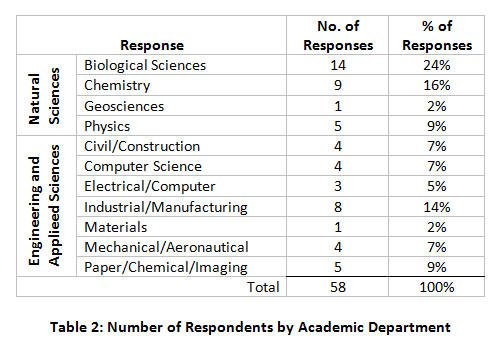
Not all 58 respondents chose to answer each question. For each question, the given percentages refer to the percentage of respondents answering that particular question. For survey questions 5, 6, and 8 through 12, participants could select more than one response; the totals in Figures 2 and 4 through 7 may be greater than 100%.
In general, the respondents were made up primarily of researchers who have been engaged in research for some time (Figure 1), with the greatest number of respondents (38%) having done research 20-29 years.
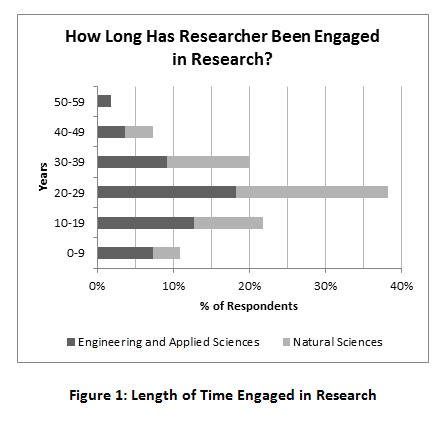
Overall, 90% of the 58 respondents use some type of CA service. Table 3 shows what types of CA services are used by the respondents. A much greater number of engineering faculty claim to use web sites and online peer networks than do natural science faculty (38% to 12% and 33% to 24%, respectively).
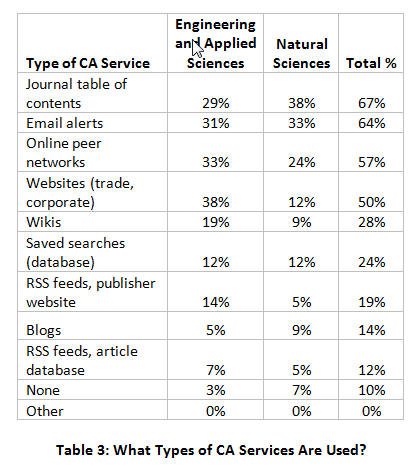
Figure 2 shows the types of CA services our faculty most frequently use. The top two CA services by far are e-mail alerts (32%) and journal tables of contents (25%) with web sites and online peer networks a distant third and fourth. The top two preferences of our respondents overlap with the top two preferences expressed by Fernandez's (2002) faculty (e-mail alerts, journal tables of contents), showing that apparently little has changed in the intervening decade. Few researchers in our study used RSS feeds, either as a feed on a publisher's web site (19%) or from an article database (12%). RSS feeds from an article database and blogs were more or less tied for the least-used CA services.
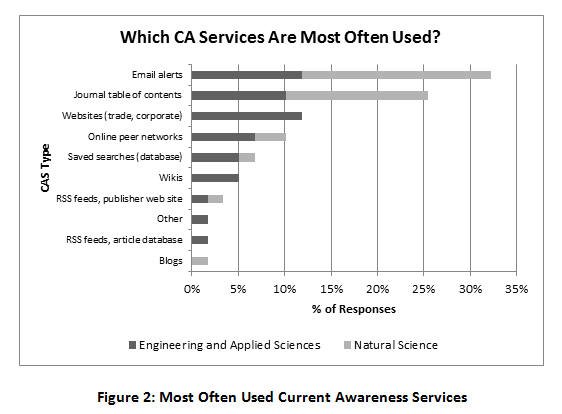
A majority (53%) of faculty monitor their CA services on a weekly basis; another 25% do so daily (Figure 3). Interestingly, the vast majority of natural-science respondents to this question (17 out of 24) monitored their CA services weekly, whereas engineering faculty were split nearly evenly between the weekly and daily options (10 and 9, respectively). Are there inherent differences in the workloads, routines, or goals of natural scientists versus engineers that could account for such a difference?
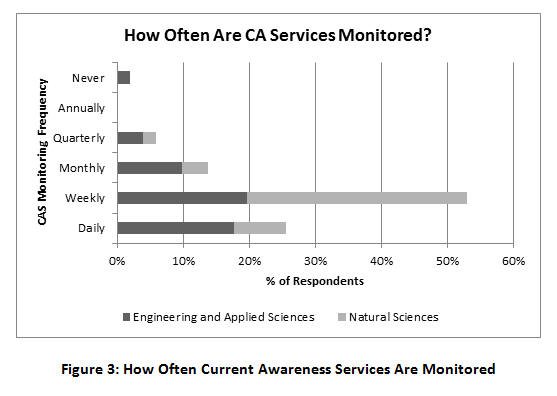
Faculty indicated the three greatest CA contributions to their teaching and research are awareness of other researchers (77%), awareness of research results (71%) and, saving time searching (71%) (Figure 4). Only one respondent supplied an additional reason (under "other") for using CAs: "Allows me to go at my own pace. Catch up when I need to, or ignore entirely." Respondents were able to choose more than one answer for this question, and most did. Many of the reasons for using the CAs listed in the survey are intertwined (such as "Awareness of research results" and "Ideas for research"), indicating overlapping needs.
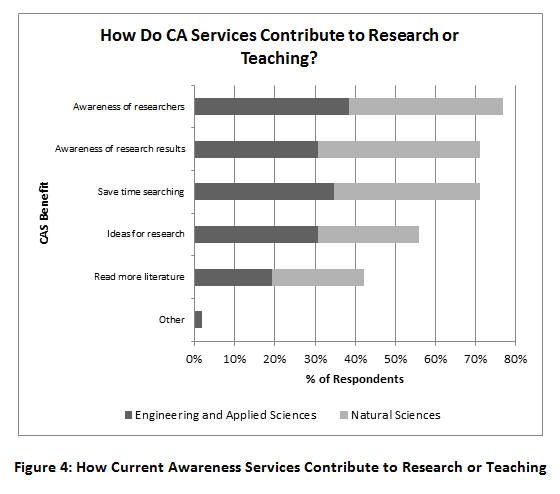
Faculty were most often alerted to research in their subject areas (85%), journal tables of contents (58%), and grant opportunities (42%) (Figure 5). In addition, twice as many natural science faculty used CA services to receive tables of contents than engineering faculty. Two possible explanations for this result are that there may be a greater emphasis on peer-reviewed literature in the natural sciences and that engineers tend to monitor their literature on an as-needed basis rather than regularly (Tenopir and King 2004).
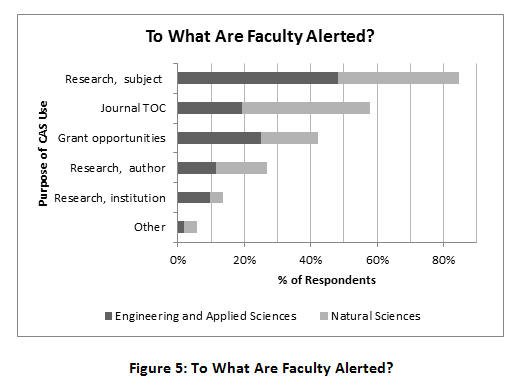
The vast majority of respondents found out about the CA services they use from browsing the web (71%) or from a colleague (61%) (Figure 6). A distant third learned about CA services from a librarian (29%).
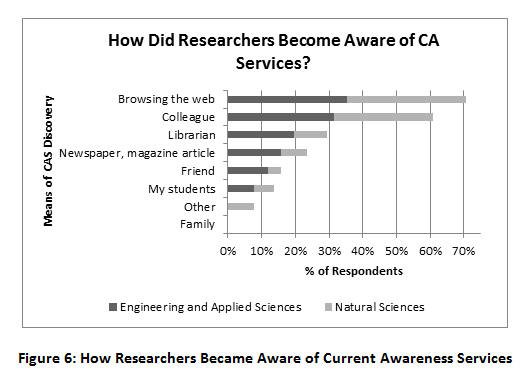
Most researchers taught themselves how to use these tools (92%) with some also using a web page (22%) or receiving help from a colleague (18%) (Figure 7). Relatively few learned to use these tools from a librarian (14%).
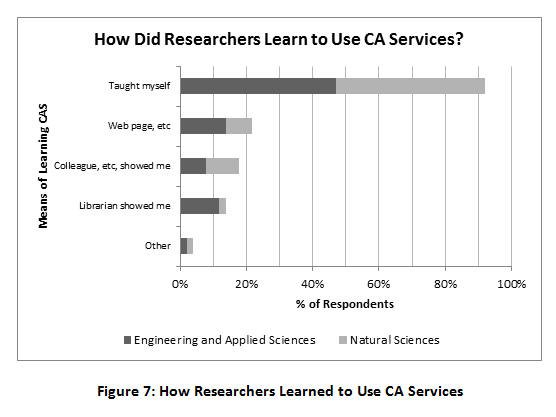
For the respondents who do not use CA services (Figure 8), no particular trend was apparent. The reasons most often chosen were "Don't have time to check" or "Don't have time to learn" how to use CA services (three and two responses, respectively). Otherwise, it appears that people have idiosyncratic reasons for not using CA services. Four responses indicated the reason as "other": "No reason for use for 21 years"; "Probably lack of awareness of what's out there and what the tools can do"; "there is too much, but so little fits my current work"; "Not currently doing research."
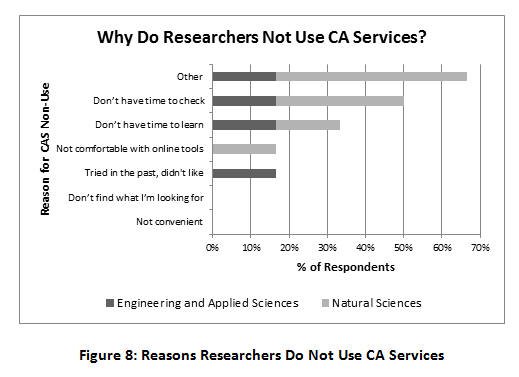
A significant number of respondents (57%) indicated they would be interested in attending a library training session that covered all types of current awareness tools, with engineers showing slightly more interest than natural science faculty (32% to 25%). Over twice as many respondents in the 45-65 year age range were interested in receiving training than respondents in other age groups (Figure 9). Perhaps older faculty members who are still active in research are more likely to want help than younger colleagues who may already know how to use such services effectively enough for their purposes.
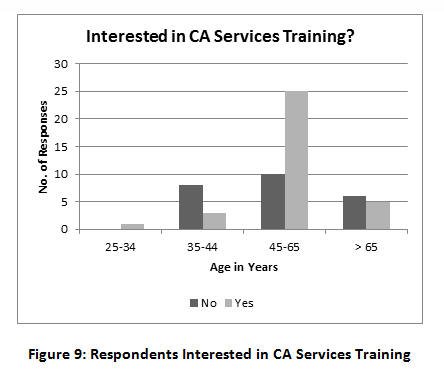
Conclusion
While the small sample size and low response rate to many of the individual questions prevents generalizing our results across relevant/other departments at WMU or across other universities (Connaway and Powell 2004), this study provides intriguing results that begin to address the void identified by Sullivan (2004) regarding faculty awareness of CA services. This study points to the need for a broader, wider study of current awareness use by natural sciences and engineering faculty.
It would have been interesting to have asked respondents why they did not use specific types of CA services, such as RSS feeds. As mentioned earlier, the Fernandez study (2002) predated the widespread use of RSS so it was not addressed in that study. Even 10 years later, with RSS feed technology more widespread, we found that RSS is little used for current awareness among science and technology faculty at WMU.
Since more and more database vendors and publishers are offering RSS as a standard feature, it would be helpful to know what obstacles stand in the way of its use by researchers. As mentioned by Blackburn and Walker (2008), part of the problem may be that there is no universality in RSS feed options. Every publisher and database vendor does RSS in a slightly different way, with some requiring the extra step of individual user accounts for access to the RSS feed. All of this can be confusing, inconvenient, and off-putting to users.
If the low use of RSS feeds for current awareness by academic science and technology researchers holds among a larger, multi-institution sample, this would indicate a possible need for more instruction on how to use RSS feed technology, easier ways to access and read RSS feeds, and perhaps a change in the information culture itself. For example, had someone done a study of e-mail or online journal alert use in the late 1980s, one might have found that e-mail or journal alerts had low use at that time, because few publishers were offering those options and fewer faculty were regularly using e-mail. But after 20 years, both e-mail alerts and online journal tables of contents have become the standard way of accessing current awareness information. Perhaps the use of RSS feeds for current awareness will increase over time as well, as more faculty discover how to utilize the RSS feed options already available on many database and journal web sites.
As long as e-mail continues to be the primary communication tool among researchers, it will perhaps remain the predominant means for receiving current awareness information as well. To the extent that faculty are forced to log in somewhere else to get their current awareness information (whether through a feed reader or a database), they will probably avoid it.
Since over half of the WMU faculty indicated they would like CA instruction, perhaps it would be worthwhile for us to provide such an option to our faculty. This would give them an overview of the CA services available, and enable them to make a more informed choice as to what, if any, CA services to use. Although faculty may express interest in the option of instruction, they may not pursue it, given limited time and resources. Not a single faculty member who responded to this survey has requested such assistance. It could be that scientists and engineers prefer to teach themselves how to use research tools, as our survey seems to indicate. Certainly, past experience in our library has shown that faculty attendance at such workshops tends to be very low.
Ultimately what CA tools faculty use will depend on their own individual needs, which may vary considerably from person to person.
References
Aims, A. 1965. Survey of information needs of physicists and chemists. Journal of Documentation 21(2):83-112.
Barker, F.H., Veal, D.C., and Wyatt, B.K. 1972. Report on evaluation of an experimental computer-based current-awareness service for chemists. Journal of the American Society for Information Science 23(2):85-99.
Blackburn, G. and Walker, M. 2008. Rightly sore subscribers: where libraries are going wrong with RSS. Brick & Click Libraries: Proceedings of an Academic Library Symposium. Maryville, MO, Northwest Missouri State University. p. 79-85.
Bond, V.B., Bowman, C.M., and Brown M.T. 1969. A computerized current awareness service using Chemical-Biological Activities (Cbac). Journal of Chemical Documentation 9(3):158-161.
Bowman, C.M. and Brown, M.T. 1971. The development, cost, and impact of a current awareness service in an industrial organization. Journal of Chemical Documentation 11(2):72-75.
Chahla, M., Eberlein, M., and Wright, S. 2010. The effect of providing a USB syllabus on resident reading of landmark articles. Medical Education Online [Internet]. [Cited 2011 25 Jan]; 15. Available from: http://med-ed-online.net/index.php/meo/article/view/4639/5304
Connaway, L.S. and Powell, R.R. 2010. Basic Research Methods for Librarians. Santa Barbara, CA: Libraries Unlimited. p. 117-118, 130, 166.
Connor, J.H. 1967. Selective dissemination of information: a review of the literature and the issues. The Library Quarterly 37(4):373-391.
Current awareness. 2003. In: Feather J, Sturges P, editors. International Encyclopedia of Information and Library Science. 2nd ed. London; New York: Routledge. p. 118.
Current contents list. 2003. In: Feather J, Sturges P, editors. International Encyclopedia of Information and Library Science 2nd ed. London; New York: Routledge. p. 118.
Fernandez, L. 2002. User perceptions of current awareness services: A faculty survey. Issues in Science and Technology Librarianship [Internet]. [Cited 2010 22 Nov]; 33. Available from: http://www.istl.org/02-winter/article3.html
Garfield, E. and Sher, I.H. 1967. Asca (Automatic Subject Citation Alert) - a new personalized current awareness service for scientists. American Behavioral Scientist 10(5):29-32.
Grossnickle, J., Board, T., Pickens, B., and Bellmont, M. 2005. RSS - Crossing into the mainstream [Internet]. Available from: http://web.archive.org/web/20051013063727/http://publisher.yahoo.com/rss/
Harris, G. and Marshall, J.G. 1996. Building a model business case: Current awareness service in a special library. Special Libraries 87(3):181-190.
Hensley, C.B. 1963. Selective dissemination of information (SDI): State of the art in May, 1963. AFIPS. New York, NY: Association of Computing Machinery (ACM). p. 257-262.
Jordan, J.R. 1970. Let the computer select your reading list. Datamation 16(2):91-94.
King, A. 2001. The evolution of RSS [Internet]. [Cited 2010 8 Dec]. Available from: http://www.webreference.com/authoring/languages/xml/rss/1/
Kolder, H. and Simpkins, I.F. 1967. Selective dissemination of information and the academic science library. College & Research Libraries 28(1):53-57.
Luhn, H.P. 1961. Selective dissemination of new scientific information with the aid of electronic processing equipment. American Documentation 12(2):131-138.
Martyn, J. 1964. Unintentional duplication of research. New Scientist 21(377):338.
Menzel, H. 1964. The information needs of current scientific research. The Library Quarterly 34:4-19.
Meyer, R.L., Meskin, A.J., Mracek, J.J., Schwartz, J.H., and Wheelian, E.C. 1971. User study of current awareness and SDI at Celanese Research Company. Journal of Chemical Documentation 11(1):24-29.
Neilson, C. 2008. Current awareness on a shoe string: RSS at the HQC. Internet Reference Services Quarterly 13(1):57-67.
Niu, X., Hemminger, B.M., Lown, C., Adams, S.J., Brown, C., Level, A., McLure, M., Powers, A., Tennant, M.R., and Cataldo, T. 2010. National study of information seeking behavior of academic researchers in the United States. Journal of the American Society for Information Science and Technology 61(5):869-890.
Resnick, A. and Hensley, C.B. 1963. Use of diary and interview techniques in evaluating a system for disseminating technical information. American Documentation 14(2):109-116.
Roberts, A.B., Hartwell, I.O., Counts, R.W., and Davila, R.A. 1972. Development of a computerized current awareness service using Chemical-Abstracts Condensates. Journal of Chemical Documentation 12(4):221-223.
Rosch, H. 2003. Dissemination of information. In: Feather, J. and Sturges, P., editors. International Encyclopedia of Information and Library Science. 2nd ed. London; New York: Routledge. p. 141.
Skolnik, H. 1977. A computerized current awareness system for journal literature. Journal of Chemical Information and Computer Sciences 17(2):75-78.
Strauss, L., Strieby, I.M., and Brown, A.L. 1964. Scientific and Technical Libraries: Their Organization and Management. New York: Wiley-Interscience.
Sullivan, P. 2004. Information overload: keeping current without being overwhelmed. Science & Technology Libraries 25(1/2):109-125.
Teitelbaum, P. 1973. Case history on use of Spin (Searchable Physics Information Notices) tapes for current awareness service. In: Waldron, H.J. and Long, F.R., editors. Proceedings of the American Society for Information Science: Innovative Developments in Information Systems: Their Benefits and Costs. Los Angeles, CA: American Society for Information Science.
Tenopir, C. and King, D.W. 2004. Communication Patterns of Engineers. Hoboken, NJ: John Wiley. p.59.
Wittenbrink, H. 2005. Really Simple Syndication - RSS 2.0 and Its Predecessors [Chapter 2] . In: RSS and Atom: Understanding and Implementing Content Feeds and Syndication. [Internet]. Birmingham, England: Packt Publishing; [cited 2011 May 27]. Available from: http://www.books24x7.com/
Appendix A
Current Awareness Services Survey (PDF)
| Previous | Contents | Next |
